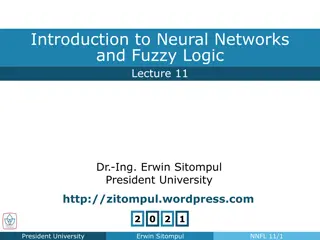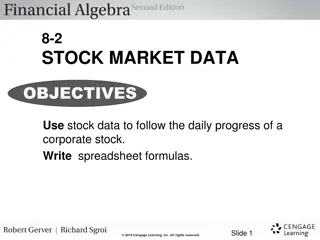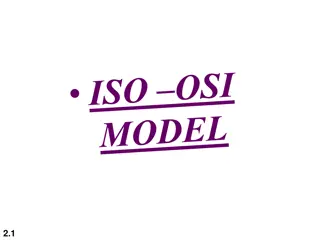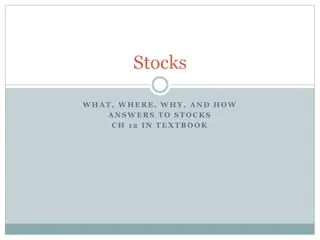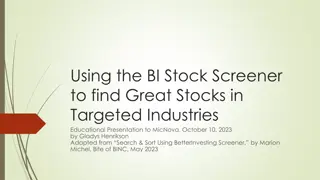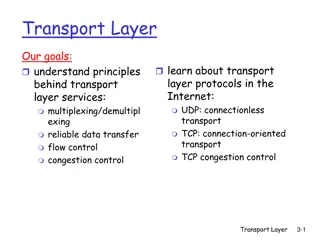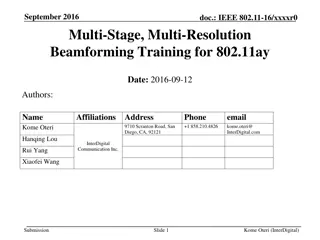Multi-layer Stock Trader Using Deep Learning
This study presents a multi-layer and multi-ensemble stock trader utilizing deep learning and deep reinforcement learning. The proposed approach leverages different layers for preprocessing, reinforcement meta-learning, and ensembling to enhance stock trading strategies. By combining deep learning techniques and ensembling methods, the system outperforms traditional approaches in real-world trading scenarios.
Download Presentation

Please find below an Image/Link to download the presentation.
The content on the website is provided AS IS for your information and personal use only. It may not be sold, licensed, or shared on other websites without obtaining consent from the author.If you encounter any issues during the download, it is possible that the publisher has removed the file from their server.
You are allowed to download the files provided on this website for personal or commercial use, subject to the condition that they are used lawfully. All files are the property of their respective owners.
The content on the website is provided AS IS for your information and personal use only. It may not be sold, licensed, or shared on other websites without obtaining consent from the author.
E N D
Presentation Transcript
A multi-layer and multi-ensemble stock trader using deep learning and deep reinforcement learning Applied Intelligence 2021 2022 9 16
1. Introduction Supervised approaches still do not deal efficiently with raw past prices data and their very known limitations. Stock trader is composed of a multi-layer and multi-ensemble classifier that acts in three steps and use two ensembling techniques at the same time.
1. Introduction Contributions 1.We propose a machine-learning based stock trading system composed by three different layers, that leverages both on deep learning and deep reinforcement learning benefits, which were proven to be effective in several other machine learning fields; 2. We exploit a novel pre-processing step based on generating meta-features after converting price time- series into Gramian Angular Field images, in order to generate input data to be further processed in our stacking ensembling approach; 3. We propose the use of a deep reinforcement learning meta-learner, which processes the trading signals from Convolutional Neural Networks (CNNs) to generate the final trading decisions; 4. We combine two different ensembling steps (stacking in the second layer of our agent, and majority voting in the last layer) to maximize the robustness and stability of our trading strategy; 5. We evaluate our multi-layer and multi-ensemble approach in a real-world trading scenario, comparing our experimental results with several baselines and literature competitors, showing that it clearly outperforms their performance.
2. Proposed approach Layer #1: Stacking/pre-processing layer Layer #2: Reinforcement Meta Learner Layer #3: Ensembling Layer The proposed three layered multi-ensemble approach.
2. Proposed approach Layer #1: Stacking/pre-processing layer (i) time-series-to-image conversion; (ii) different CNNs processing; (iii) fusing of trading results.
2. Proposed approach Layer #2: Reinforcement Meta Learner rt =pt pt 1 At {1, 0, 1} update rules: loss functions:
2. Proposed approach Layer #3: ensembling multiple learners By taking a vector Lt ={l1, l2, ..., ln} of n iterations (epochs) decisions for a day t,where li {L, H, S}, the ensembling layer fuses them in just one trading signal lt as the following: The idea behind this approach is that the same agent trained at different iterations can be complementary, as the agents have different experiences with the environment thus making the approach more robust against uncertainties of the stock markets behavior.
3. Experimental Datasets:S&P 500 \ JPM \ MSFT Metrics: indicates how many times the trading agent enters the market.
3. Experimental baselines: 1.variations of the approach. a majority voting over the 1000 CNN trading signals a threshold agreement of at least 50% of the same CNN trading signals a threshold agreement of at least 70% of the same CNN trading signals. 2.some literature works that propose trading techniques based on machine learning. the authors encode trading signals (e.g: EMA, etc.) into 15x15 images, and train a CNN to perform daily trading; the authors propose a Support Tensor Machine, called LS-STM, i.e. a tensor extension of the best known support vector machine, to perform daily trading. 3. Buy-and-Hold
4. Conclusions (i)The metalearner leads to better trading results and less overfitting when we preliminary explore the training parameters and adopt the most promising ones; (ii)Compared to well-performing non-RL ensemble baselines,the approach showed a final return improvement of 28.78% when compared to our best benchmark (which, notably,has still very good performances in the considered period),by yielding returns 5.70 higher than the risk assumed, and outperforming the market not only in the crisis scenario of the 2018, but also in the following phase of 2019 in which the market showed a very solid trend; (iii)The approach provides the best performances, when tested against the strong methods ,in two different real-world trading scenarios,and when considering several distinct periods and markets.





